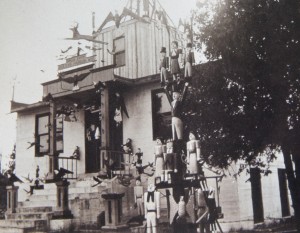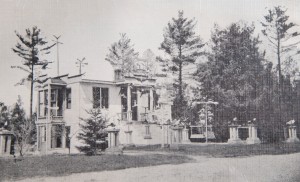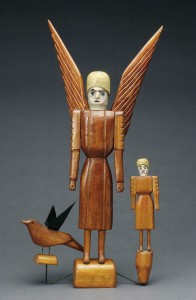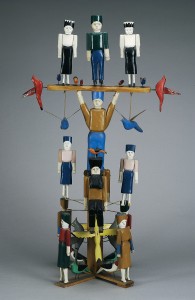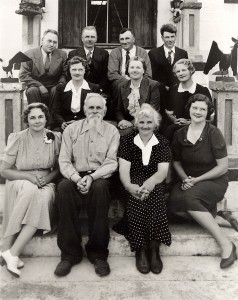Birds Park
- Share
- Tweet
- Pin
- Share

Bobby McCullough was a preschooler in 1954 when Birds Park came into his life, but he remembers very
clearly driving north through Baileys Harbor in his family’s 1947 Buick, when his mother suddenly exclaimed, “Oh, my God, isn’t that wonderful!”
The wonderful thing she’d sighted was a funny old concrete house, painted white and blue, built 30 years earlier by Albert Zahn, a retired dairy farmer. Bobby and his parents scrambled out to investigate, noticed a small “for sale” sign in a window, and headed straight back to a bank in Sturgeon Bay to borrow $3,000 to purchase the property.
Little Bobby couldn’t have imagined then the importance of what his family had acquired, nor the role Zahn and his little house were to play in the rest of his life.
Albert August Zahn was born in 1864 in Natelfitz, Germany, just south of the Baltic Sea. He had a few years of Lutheran schooling and worked, according to various family stories, as either a sheep or goose herder. His interest in whittling began as he sat in the fields, watching over his flocks. When he was 15, his father Carl, brought the family to America so that Albert and his older brother could avoid conscription into the German army.
They settled in Forestville, where Albert worked for a well digger. By 1883, his father paid $150 – with $50 down – for an acreage a few miles northeast of Baileys Harbor, where Albert established a dairy farm he named Silver Dew. In 1891, he married 15-year-old Louise Strege of Forestville, and over the next 30 years, they became the parents of 10 children, nine of whom lived to adulthood. In the early 1900s, Albert’s nephew August Zahn arrived from Germany, and Albert helped him build the blacksmith shop and large home next door that is now the Blacksmith Inn in Baileys Harbor.
Farming occupied Albert’s time for 40 years, but in the evenings he sat by the fire and carved little birds and other figures that he used to “trim” the porch railings of the house. In 1924, at age 60, Albert turned the farm over to his oldest son, Albert, Jr., and set about building a retirement home on the north edge of Baileys Harbor. He made his own concrete and cast the walls, a layer at a time, until they were two stories high. Pieces of cedar were randomly inserted into the wet concrete to absorb moisture, so that the inside walls wouldn’t sweat. What Albert called the basement, a few steps below ground level, was
devoted to the kitchen/living area and two small bedrooms. Upstairs was a spare room and the parlor that grandchildren remember was used only on Christmas, when the tree was trimmed with candles and home-made decorations. The “facilities” were 50 yards behind the house. Eventually, a “penthouse” was added atop the second story, purportedly to provide easier access for repairing leaks in the roof, but primarily to serve as a base for the wind charger Albert installed to avoid “renting” electrical power.
Once the house, named Birds Park, was completed in December 1924, Albert did not, of course, sit back and take his ease. He built almost all of the family’s furniture, often elaborately carved with animals. The unusual table he created with a fold-out section to hold his out-sized German Bible featured a pair of lions, and the back of a platform rocker was topped with a large carved owl. He spent summer days in the 20 acres of swampy woods a few miles from his home, cutting cedar posts that he sold to Brann’s Store, and was employed by Dr. A. J. Gordon to build the cottages at Gordon Lodge, walking the six miles to and from the lodge without complaint if Dr. Gordon failed to show up to give him a ride.
The ready availability of cedar and free time in the evenings enabled Albert to resume his carving, first as a pastime, but later as a business enterprise. Every night, his children remembered, he’d sit by the wood stove and fashion birds, animals, angels, sea captains and boats – accumulating a pile of shavings that were a constant source of irritation to Louise. Her opinion of his hobby softened when he enlisted her to paint his creations. She used a little book as a guide, so that the colors of each bird would be accurate.
The inside of the house was soon full of Albert’s carvings, and he began to attach them to the outside.
When those spaces filled up, he cast concrete pillars along the road to display them and large basins, often mistaken for birdbaths, for his boats. Hundreds were given away to friends and neighbors. Albert was dumbfounded when strangers began to stop and ask to purchase his carvings. His initial response was to continue to give them away, but eventually his daughter, Louise, by then a more sophisticated Chicago resident, convinced him to sell the small birds for a quarter and the large black eagles, like the one that adorned the roof, for $5. Albert’s angels, always with wings raised toward Heaven, were
especially popular, as were his signature family trees, multi-levels of figures representing each generation, interspersed with little birds.
When his wife died in 1950, Albert no longer had anyone to paint his creations, and his interest waned. He soon went to live with his son Elmer in Sturgeon Bay, where he died in 1953 at the age of 89. According to Bobby McCullough, Albert’s family never took his hobby seriously, and the community thought he was a bit strange.
Albert’s children remembered him as a quiet, gentle man, with snow-white hair, mustache and flowing beard. A deeply religious man, he played the organ at Christ Evangelical Lutheran Church when he was a young man and later attended Immanuel Lutheran in Baileys Harbor. He spent hours every Sunday reading his Bible and believed that all men were created equal before God and that the natural world was the most spiritual of places. Most of his carvings, his children said, had a Biblical reference, especially the Psalms.
When the McCulloughs bought the house the summer after Albert’s death, it was showing serious signs of deterioration. Most of the outside carvings had disappeared. While many others were still inside, there had been break-ins and vandalism there, as well, and small animals had taken up residence after Albert left. Bobby’s parents, both artists, found Albert’s carvings charming, and Bobby, decades later, describes his relationship with Birds Park as “50 years of paradise.” But none of them, and certainly not Albert’s family, foresaw what would happen to the reputation of the “bird man” decades after his death.
In Door Way, a 1981 book by Door County author Norbert Blei, he says of Zahn, “The purity of the artist is such a rare thing these days. And if the work of Albert Zahn continues to fascinate me, it is primarily because of the combination of purity and primitiveness in the man, the art. There is something incredibly ancient and refreshing about a man ‘making art’ just for the sake of making art (like the American Indians), unconscious of artistry, value, or fame, if any, in the world of art.”
Zahn’s growing fame was not confined to Door County. Publicity had begun to appear in Milwaukee newspapers in the 1930s and 1940s, and the family remembers that artists often came to paint Birds Park, but were more interested in the house than in their father or his carvings. A 1933 clipping, probably from the Milwaukee Journal, is titled “Wooden Birds His Companions,” and shows Albert standing on the front steps of his “strange home” beside a carving of a deer surrounded by birds.
Shortly after Albert’s death, one of his daughters contacted Neva Krohn at the Benjamin Gallery on Chicago’s Michigan Avenue and inquired about selling a number of her father’s carvings. The gallery typically dealt in the works of famous artists like Henry Moore and Pablo Picasso, but Krohn was familiar with Zahn’s creations and agreed to take them. They were unceremoniously transported to Chicago with a truckload of cherries.
In 1965, the Benjamin Gallery held an exhibition of Zahn’s pieces. The Chicago Tribune noted, “Now that his carvings have moved into a big city milieu, their excellence may win for Zahn a prize that he never dreamed of. He may become part of the establishment.” Actually, Zahn’s fame would grow because he had not been part of the establishment, but was what came to be known as an “outsider” or “isolete” artist.
Carl Hammer, whose Chicago gallery was another early promoter of Zahn’s work, says, “He was compelled to carve his private vision of the people who came before him and of an afterlife. He had a strong sense of where he came from and a vision that extended beyond the earthly level. He’s in the category of highly-recognized folk artists.
“The academic art world didn’t pay much attention to artists like Zahn,” Hammer continues, “because
they had not gone to school to learn ‘how to look at art,’ but had their own vision. Since the 1970s, we’ve seen an amazing revolution.” Hammer has 12 of Zahn’s carvings in his personal collection and has “turned on” dozens of others like Orren and Marilyn Bradley of Egg Harbor, who have 25 Zahns among their vast collection of folk art.
In the late 1970s, the National Endowment for the Arts and the Wisconsin Arts Board began a project to preserve the work of self-taught folk and vernacular artists, stressing the conservation of the outdoor environments they had created for themselves. Nearly 20 years later, in 1998, Leslie Umberger, senior curator of exhibitions and collections at the John Michael Kohler Arts Center in Sheboygan, discovered Zahn’s work at a display of the Bradley’s collection at the Peninsula Art School in Fish Creek and was “blown away” with the works’ simple elegance and poetic force.
With special help from Carl Hammer and the Zahn family, Umberger was able to assemble more than 200 original Zahns from family members, collectors and galleries in nine states and the District of Columbia for a major retrospective titled “Albert Zahn: I’ll Fly Away” that was featured at the John Michael Kohler Arts Center for several months in the summer and fall of 2003 before moving to Intuit: The Center for Intuitive and Outsider Art in Chicago that winter.
Zahn’s pieces can now be found in major museums and galleries across the country, including The Smithsonian Institution, The Art Institute of Chicago, and the Museum of Modern Art and the Guggenheim Museum, both in New York City. The Kohler Arts Center now has an impressive collection, including many pieces purchased from the Zahn family, most of whom did not, years ago, realize the value of their inheritance. McCullough tells a great story about one of Zahn’s daughters offering to give him a carving that he knew was worth at least $1,000. “I coveted that piece,” he says, “but I told her the importance of what she had and that it had to stay in her family. It was one of the great moral battles of my life. It would have been easier to turn down a bribe of $100,000!” He had a similar experience with a Birds Park neighbor, who told him proudly that the cardinal doorknocker Albert carved 50 years earlier was still on her front door. He told the shocked woman its worth – at least $1,000 in a Chicago gallery – and suggested that she display it inside.
Hammer says that Zahn’s pieces are becoming harder to find, either because people who own them don’t realize what they have or because they do realize their value and don’t want to part with them. Last summer, a purported “lost Zahn” carving of a 14-inch female figure appeared. Hammer, great-grandson Randy Zahn, the Bradleys and Bobby McCullough were perplexed because the piece had Albert Zahn’s name on the bottom, and they all were aware that he’d never signed his carvings. However, the woman’s nose was carved separately and glued on, as was the case with all of Albert’s figures. After careful study, they agreed that it is an original, undoubtedly signed with Zahn’s name by the person who first acquired it. As pieces become scarce, prices predictably increase. One of those little birds that originally cost a tourist a quarter sold at a Sotheby’s auction in New York in 1998 for $1,200. The price would undoubtedly be much higher today.
When Bobby McCullough moved to Oregon and his parents grew older, the upkeep of Birds Park faltered. Bobby became involved in the 1980s, and in the early ‘90s after his mother’s death, he and his wife Karen (whom he calls his Italian princess) decided to undertake a total restoration of Birds Park. It took several years to find master workmen who understood Bobby’s commitment to returning the 70-year-old home to its original state, but in 1993 the process began.
Walls in the kitchen/living area were covered with ten layers of wallpaper, and the floor with nearly as many sheets of linoleum. Tin piping from Sears & Roebuck was attached to three wood stoves and run up through the walls, and the charred rafters bore evidence of many chimney fires. “Evidently he was living good,” McCullough said, “because luck was with him all those years, and he never had a crisis.”
As the interior was stripped down to the studs, it became obvious that there wasn’t a right angle in the house. “Albert Zahn, despite having an artist’s eye, did not have an engineer’s measuring stick,” McCullough observes. “The house was always more creative than practical.” Zahn had built all the windows and doors before the house was completed, doing his milling by hand with a crosscut saw and using whatever materials he had at the moment. McCullough remembers that Bernie Fabry, the wonderful carpenter he found, never quite understood the spirit of restoration. “He’d say, ‘What do you mean you want a whopper-jawed door? I’ve never in my life built a door that wasn’t square!’” McCullough recalls with a wonderful Irish laugh. All the lumber from inside the house was saved, and about half of it was reused. A small kitchen and a bathroom replaced the two lower-level bedrooms, but otherwise the interior looks exactly as it did when the Zahns lived there.
Kim Wilde, a Door County contractor, who often drove by Birds Park when the renovation was underway, left a note on McCullough’s car one day in 1998 saying, “I’d like to fix your house.” McCullough says that Kim also did remarkable work over a nine-year period, restoring the front and back steps, which were originally shells of concrete over gravel, replacing sidewalks, rebuilding the flat roof and replicating exactly the concrete columns in front of the house that Zahn had built to display his carvings.
Wilde is pleased that Zahn’s love of animals and nature lives on at Birds Park. “We left a little green frog above the big eagle on the roof and a bat below it,” he says. “And we planted vegetables and herbs in the yard, because that’s what Alfred Zahn would have done. In fact, he used to have a potato patch by the house instead of a lawn.”
McCullough loves to tell a story about the original southernmost column. “Albert’s children say he was a peace-loving man who never lost his temper except at an occasional Baileys Harbor town meeting. However, he had a running disagreement with his next-door neighbor, who insisted that the column in question was located five feet inside his property line. Albert, of course, said it was not. When Albert died, the neighbor dug up the column and relocated it five feet to the north.
“When the Zahn property came into my possession,” McCullough says, “I bought the neighbor’s property and put that column right back in its original spot. I’m sure Albert is smiling in Heaven, knowing he got the last word!”
Because all of Zahn’s outside decorations had disappeared by the time McCullough took possession of Birds Park, they have been replaced by duplicates created by his great-grandson Randy, whose family lives on Albert’s original Silver Dew farm. A gifted craftsman, his birds and other pieces, very like Albert’s, can be found at Newport House Gallery in Ellison Bay, run by folk art specialists Jan Jenkins and Carol Lango, who are credited with introducing the McCulloughs to the Bradleys. Randy’s Uncle Ed, a grandson of Albert and Louise, is also a fine carver whose birds and family trees strongly resemble Albert’s work. So, Albert’s talent and his vision continue to be expressed through later generations.
There is new life, too, for Birds Park, where the 15-year restoration is finally complete. On summer days, when Bobby and Karen are in residence, the little house and the display of carvings outside again attract the attention and admiration of passersby. Through the efforts of Mary Ann Johnson, Albert’s home and the old blacksmith shop and Blacksmith Inn he helped his nephew build nearly a century ago were placed on the National Register of Historic Places in 2000.
Last summer at a program at the Peninsula School of Art, Leslie Umberger announced that Birds Park is one of six “American masterpieces” – artist-created outdoor environments that the Kohler Arts Center will become responsible for maintaining with financial support from the National Endowment for the Arts and the Wisconsin Arts Board. Zahn and his work are also featured in Kohler’s recent publication, Sublime Spaces & Visionary Worlds: Built Environments of Vernacular Artists – a wonderful tribute to a unique, mystical place that would have totally amazed the former sheep – or goose – herder who created it.



